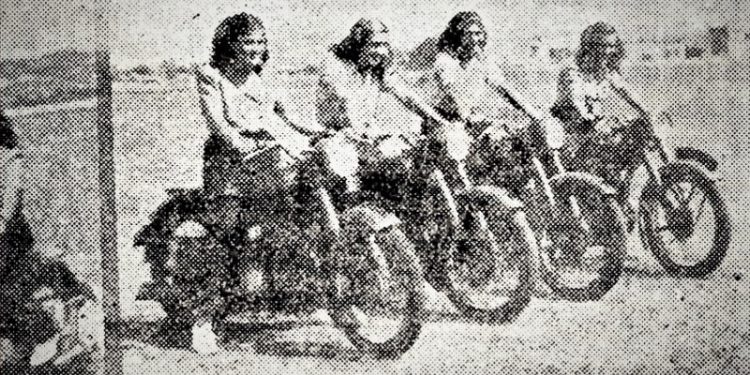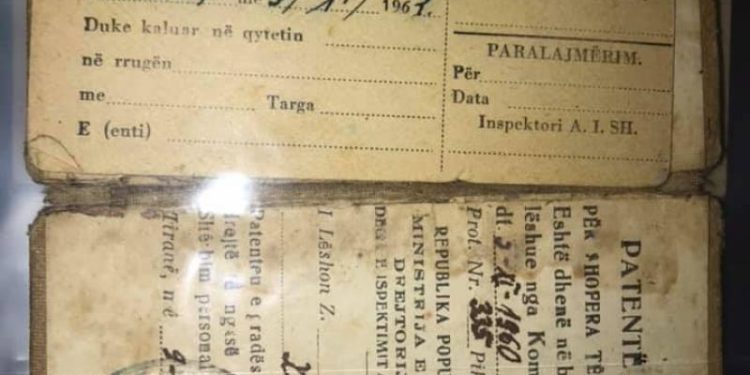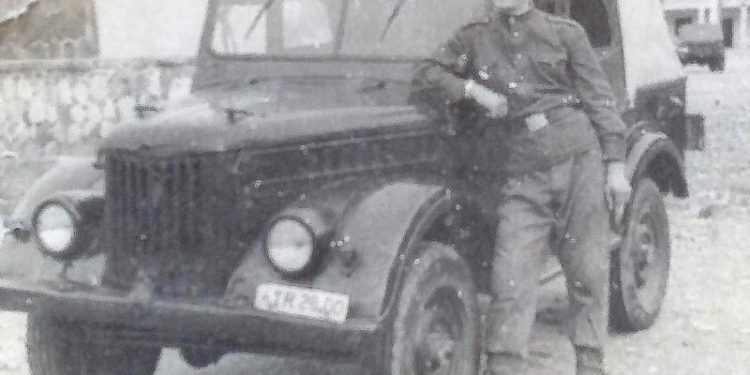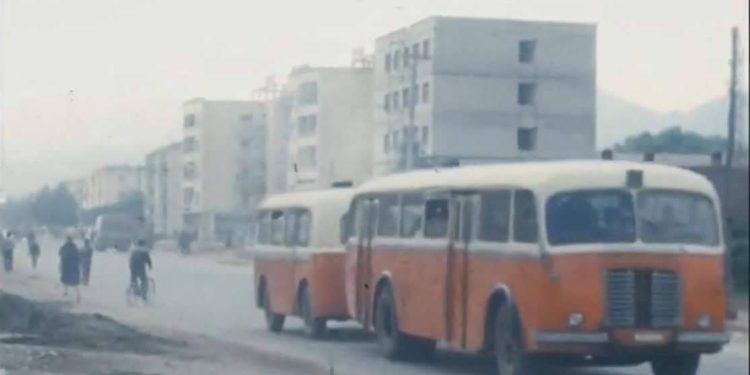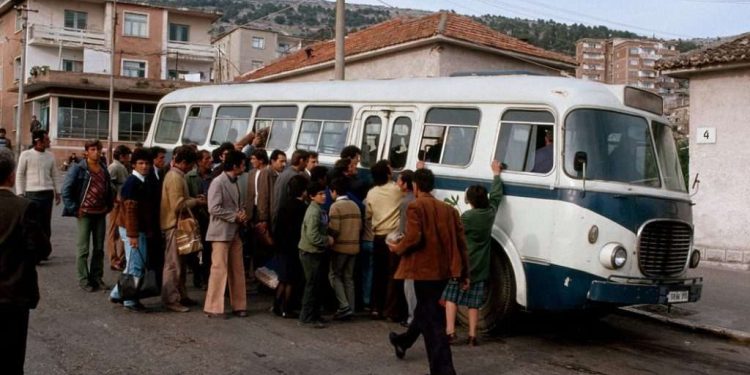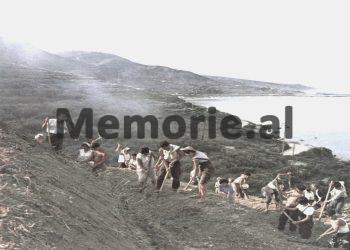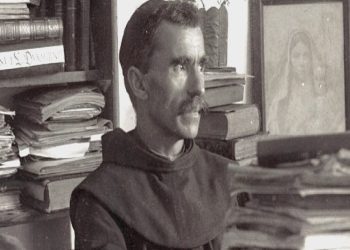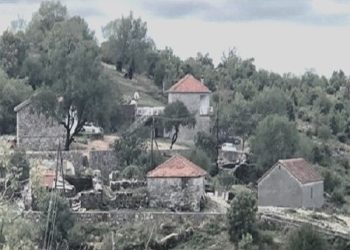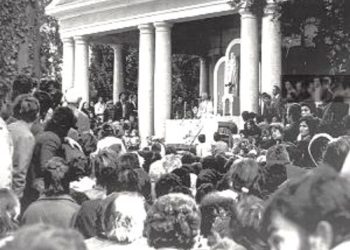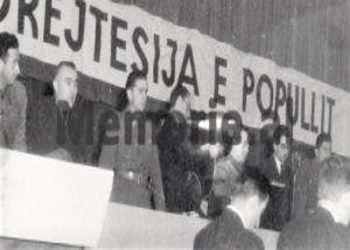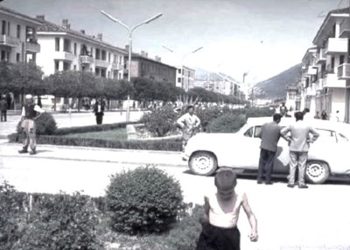On November 28, 1932, on the occasion of the 20th Anniversary of Independence, the Tirana-Durrës-and-back car race was held, which was won by the Italian Massarini, with a speed of 57 km/h, followed by Andrea Shkreli.
Memorie.al / Albania at the beginning of the 20th century was characterized by caravan routes that connected the most important centers of the country with the coast and neighboring countries for trade exchanges. These routes ran through the valleys of Shkumbin, Vjosa, Drin, Devoll, and along the coast. During this period, traces of the Egnatia Road existed, which started with two branches from Dyrrah (Durrës) and Apollonia, passing through Klodiana (Peqin), Skampini (Elbasan), Lyhnidi (Ohrid), Heraklea (Bitola), Edessa, Pella, and Thessaloniki. The length of this road was 395 km. This road was extended to Byzantium in the 1st century AD. The declaration of independence found the country with 160 km of carriage roads (Shkodër-Lezhë, Lezhë-Shëngjin, Gjirokastër-Kakavi, Delvinë-Sarandë, Durrës-Tiranë).
The First Car in Albania
The first car in Albania is thought to date back to 1913, owned by an Albanian from Çamëria, F. Sulioti. The vehicle was of the Italian brand “Fiat”.
The Decree-Law “On the service of Automobiles and every motor-powered carriage”
On April 10, 1924, the High Council of the Albanian State approved the Decree-Law “On the service of Automobiles and every motor-powered carriage.” According to this law; “Motor-powered carriages are called automobiles, motorcycles, tractors, and any other motor-powered carriage that operates on public roads and squares and is not connected to railway lines.” To drive a vehicle, a citizen had to be equipped with an Operating Permit (Circulation Permit) and a Driver’s Permit (Driving License). The age for obtaining the license was 20 years old.
483 Motor-Powered Carriages (Vehicles) in Circulation
In 1926, the number of motor-powered carriages in Albania according to Prefectures was: Shkodër – 47; Tirana – 85; Durrës – 70; Elbasan – 25; Berat – 33; Vlorë – 21; Korçë – 119; Gjirokastër – 83. A total of 483 motor-powered carriages.
Transport Association 1926
In 1926, the largest number of motor-powered carriages was in Korçë (a total of 119), where the “Automobilists’ Association” was developed, which organized car races.
The First Car Race
On March 14, 1927, the first car race was organized in Korçë. The race was organized by the “Automobilists’ Association” in Korçë.
Establishment of the “Tirana” Automobile Company
In 1928, the “Tirana” Automobile Company was established. The first motorcycle race took place on November 28, 1932, on the occasion of the 20th anniversary of the Declaration of Independence, Tirana-Durrës and back. The race was won by the Italian Massarini, with a speed of 57 km/h, followed by Andrea Shkreli.
The First Driver’s License
A driver’s license (driving permit), is one of the oldest preserved documents we have to this day, issued on June 7, 1929. The license was issued to H. B., born in Durrës.
First Car Race in Vlorë – September 24, 1929
On September 24, 1929, the first car race was held in the city of Vlorë.
The Second Automobile Race in 1931
In 1931, the second automobile race in Albania was held on the same track where the tire tracks and impressions of the first race still lingered. This race had higher participation, more fans, and even stronger fever and competition than the first. The singular name of the race stood out immediately; it was Vlash Rama, a Durrës native with a “Renault”, who crossed the finish line first. With 21 minutes and 08 seconds, as the chronicle of the time states, he snatched the “Vlora” trophy.
The Royal Touring and Automobile Club – 1932
A document we are publishing in this article sheds light on the possible existence of the Albanian Touring and Automobile Club. It is thought that the Club’s symbol was created around the years of the Albanian Monarchy (1928 – 1939). It should be emphasized that although Albania is mentioned in the registers of KNAC in 1932, there are no references to the existence of an Albanian automobile club.
The 1935 Draft Law to Limit Vehicle Imports
In December 1935, the Albanian government deposited a draft law in Parliament that provided for measures to restrict the import of certain goods, including vehicles. The ban on the import of this category was argued by the fact that; “The number of cars in Albania today is sufficient to meet the needs of the country and can be considered excessive, given the current economic situation.” The decision was approved in Parliament on February 3, 1936.
Road Network in 1939
After 1920, the construction of the Peqin-Elbasan, Elbasan-Lixhë-Gostimë, Librazhd-Peshkopi roads began, and improvements were made to several other existing roads. By 1939, several other motor roads were built, such as Tirana – Ndroq-Plazh, Shkodër-Vau i Dejës-Pukë-Kukës, Krujë-Qafështamë-Burrel, Tirana-Krrabë-Elbasan. Liberation found our country with a road network of about 2200 km, damaged by the war, and with destroyed bridges.
Vehicle License Plates of 1939 – 1944
During the Italian and German occupation, in the years 1939-1944, vehicles circulated in Albania with Albanian license plates, similar to the format used in Italy, with white writing on a black background. The name of the registration center (city) was placed on the first row, and the number was on the second, accompanied by the distinguishing mark of the fascist regime. The license plates in the photos we are publishing in this article also appear to have the inscription “Public Service” above the city name, which was placed as an addition on some of them.
S.A.T.A. – (Albanian Automobile Transport Company)
In 1940, “Fiat” created the Company S.A.T.A. (Shoqëria Shqiptare e Transportit Automobilistik), which during the 1940s provided urban transport service in the cities of Tirana and Durrës. The bus models were: Fiat 626 / RN and 626 RNL.
The “Union of Truck Automobile Transport” Company
After the change of regime in 1945, state policies towards automobilism in Albania also changed. Initially, the company “Union of Truck Automobile Transport” was created. The inventory of vehicles consisted of about 300 units of different types and tonnages. With these vehicles, the Durrës Park was initially established, where all the vehicles were gathered, and later, with a part of these vehicles, the Parks of Tirana, Korçë, Shkodër, Elbasan, Vlorë, etc., were created.
In 1946, the nationalization of transport vehicles owned by individuals and Albanian companies took place, and along with the vehicles of foreign companies, requisitioned from the beginning, transport centers (parks) were established, initially in Durrës, then in Tirana, Korçë, Shkodër, and later Elbasan, Vlorë, and Sarandë. The vehicles these centers had were of the types: “Chevrolet,” “Fiat” – 364, “Mag,” etc.
First Motorcycle Race for Women
The first motorcycle race for women is considered to have taken place on July 10, 1950. The itinerary that the racers would follow was from the “Children’s Home” to the Seat of the Ministry of People’s Defense. 5 girls participated in this race, with the same itinerary, but with 5 laps, i.e., 12.5 km.
At the end of the race, the following results were achieved: Myzejen Zepishta was ranked first, with a time of 11.40″; Leonora Koraqi second, with 12.15″, and Parashqevi Kroqi third, with 12.58′”. (Taken from the newspaper “Sport” July 15, 1950).
Luxury Cars for the Leadership
In 1954, 10 “ZIS” 110 B model vehicles arrived in Albania for the main leaders of the Party and the state. In 1960, a new format for driver’s licenses was implemented. The first Albanian Tractor, type “DT-54”, was produced by the Auto-Tractor Mechanical Combine on October 16, 1978.
In the Eastern market, everything could be obtained through clearing. If you exported onions, tomatoes, and peppers, you could easily get cars. In daily practice, the drivers of the period when socialism in Albania was being built “with our own forces” said that Eastern cars consumed much more fuel than Western ones. But this did not seem to matter, as domestic oil covered the needs of state vehicle circulation without problems. The formula was known for the countries that were part of CMEA (Council for Mutual Economic Assistance). Albania had also been part of the bodies of the Communist East and could obtain cars of Eastern production, exchanging them for agricultural products or light industry and food products.
Consequently, cars of Russian, Polish, Czech, Romanian, etc., production moved in large numbers on the roads of Albania and Albanian cities. The most famous cars were “Zis,” “Gaz,” “Skoda,” “Tatra,” “Nysa,” “Zuk,” “Varshava,” “Ifa,” “Aro,” etc.
Western-produced cars were much rarer in circulation.
For the members of the Politburo of the Central Committee of the APL (Albanian Party of Labor), a series of “Benz Mercedes” 280 SEL was ordered, while a series of “Volvo” was available for the Delegations’ Park. For specific directors of various institutions and enterprises, there were “Fiat 131”, as well as some “Alfa Romeo” of Italian production.
Important government departments were also supplied with “Peugeot” cars of French production. Among the large trucks, there were some “Volvo” and “Scania” of Swedish production, which worked for the account of TIR (International Road Transport). The army also had “Volvo” vehicles for transporting armored vehicles.
For several years, some “Fiat,” “Viberti” urban buses of Italian production circulated on the streets of Tirana, which came as reparations from the Second World War. They were later replaced by the “Shkodra” buses, which the people nicknamed “Accordion”, an imitation of the “Skoda” engine. In the last years before the communist regime collapsed, French-made urban buses of the “Saviem” type, as well as some West German-made ones, “Benz Mercedes” and “Man,” were introduced.
The First Albanian Tractor
On October 16, 1978, Albania produced the first tracked tractor, type “DT-54” (with tracks), produced by the “Enver Hoxha” Auto-Tractor Mechanical Combine, which was inaugurated only by Prime Minister Mehmet Shehu, who drove it for a few meters in the square in front of the Auto-Tractor Combine.
The rest, which constituted more than 90% of the transport vehicles, were Eastern-made cars, while the highest quality private photos today come from Korçë, which can also be found on the official website of “Retro cars Albania,” where, in their citizenry, they preserved the system of the 1913-1945 period, where it was classified as the “Pioneer” city.
The period after 1990 brought new dynamics in the mass adoption of automobilism and, to some extent, extinguished the polarization based on urban traditions of automobilism. Memorie.al




